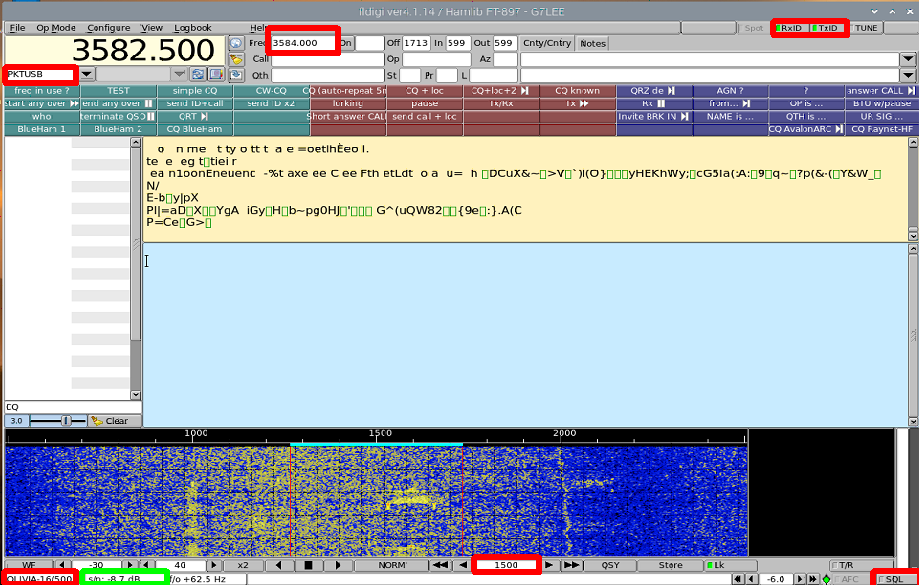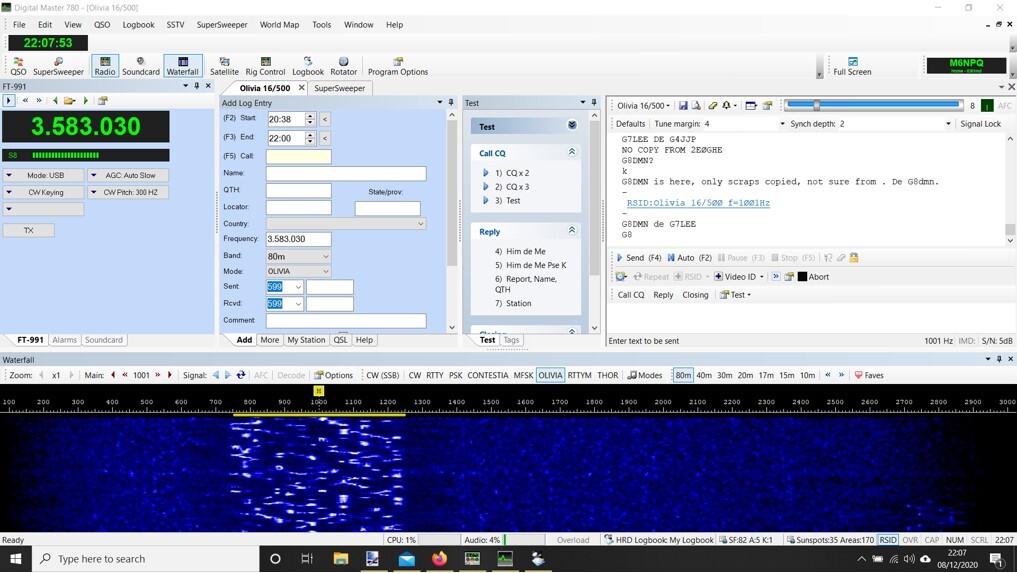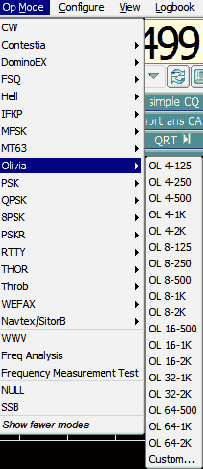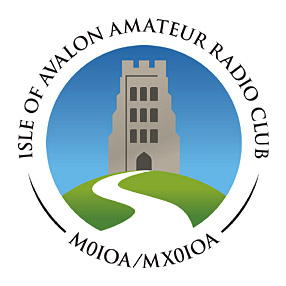South-West HF Data Net - Datamodes
Datamode Net
We have been experimenting with datamode nets which are a way of getting signals out with much less power and bandwidth requirements than SSB voice. One datamode has been widely used in Amateur Radio - Morse Code, and indeed digimode software can be used to run a Morse net, with the proviso that everyone uses the same speed machine generated Morse1 and conditions are reasonably good.
However, if you are going to use a computer than you can change the line code from on-off keying to something else, gaining robustness against noise or transient corruption. Datamode software can be set up to transfer a bit-perfect copy of the original text, automatically requesting retransmissions (ARQ2) if required. This is of value to operators in an emergency communications (emcomms) setup, and one popular software suite, FLDigi, is part of the NarrowBand Emergency Messaging Software NBEMS.
The two most popular programs for running interactive3 datamodes nowadays are FLDigi (free) and the DM780 program in the popular software suite Ham Radio Deluxe. HRD is windows-only, FLDigi runs on Linux, Windows4 and Mac. FLDigi works very well on a Raspberry Pi 3.
FLDigi supports forms and ARQ which makes it better for emcomms users. You can use either program for most of what we do.


Choosing a datamode
 When you launch FLDigi, you have to select a data mode from quite a bewildering array of modes. There are too many datamodes around - there are legacy ones from the days of mechanical teleprinters, there are some for specialised purposes like sending weather charts, and there are some which have simply been overtaken by newer technology.
When you launch FLDigi, you have to select a data mode from quite a bewildering array of modes. There are too many datamodes around - there are legacy ones from the days of mechanical teleprinters, there are some for specialised purposes like sending weather charts, and there are some which have simply been overtaken by newer technology.
We have been testing a few more common datamodes for the proposed SW net. Choosing a data mode is a balance between speed, consumed bandwidth, robustness in the presence of channel noise, fading and interference, how critical tuning is, and features.
The string for the test is
CQ SOUTHWEST NET CQ SOUTHWEST NET CQ SOUTHWEST NET DE MX0IOA MX0IOA MX0IOA
PSE K
Morse
Let’s take as a benchmark the grand-daddy of the lot, CW. I don’t do Morse, so I have to believe FLDigi that this is Morse at 18wpm. I don’t have a hope of copying that
That’s 50 seconds. Obviously less if you can do 30wpm, but roundabout 20 seems common enough.
RTTY-45
This is a mode from World War 2, which gets the job done in 20 seconds. It’s still heard
BPSK-31
Popular in the 1990s, still heard occasionally. It occupies a narrower bandwidth than many of the other modes on here. It can be demanding to tune in a net.
Olivia 16/500
A weak signal mode that can be decoded even if you can’t hear the signal
Olivia 8/500 and a slightly faster mode
and finally a faster variant
Contestia 8/500
As you can see, I’ve had to fight quite hard to get back to the speed performance of WW2 mechanical teleprinters. However, when you compare the noise performance
Modes we use
We will use Contestia 8/500 and Olivia 8/500 and Olivia 16/500
Noise immunity
cq souttwesinet cq southwestv net cqi outhwest net
de mx0ioaimx0ioa mx0ioa
pse k
on RTTY as opposed to
cq southwest net cq southwest net cq southwest net
de mx0ioa mx0ioa mx0ioa
pse k
some progress has been made across the intervening years. In practice additive white Gaussian noise is not the only signal path impairment, and interleaving the data stream with Olivia and Contestia gives better resistance against QSB and impulse interference, at the cost of extra latency.
The NVIS signal path and using the 8/500 modes
NVIS paths are not long DX paths, and there is not too much skip in the daytime, so we have favoured speed over noise immunity. Contestia is all caps but fastest and with the lowest latency. It is faster than most of us can type, as you can see if you look at the log
TX 3584000 : CONTESTI8/500 (2020-12-15 22:04Z): <NUL>WHAT DO YOU THINBK <NUL><NUL>G<NUL><NUL>4<NUL><NUL>JJ<NUL>P<NUL><NUL> - <NUL><NUL><NUL>IT<NUL> COULD BE TIME TO TAKE THIS FORWARD <NUL><NUL><NUL><NUL><NUL><NUL>AND <NUL><NUL><NUL><NUL><NUL>TEST <NUL>O<NUL><NUL>UT WITH PEOPLE FU<NUL>THER AFIELD<NUL>.
If you extract all the NUL which are padding characters sent to line because I was too slow you get what the other station sees. The typing errors are all my own work!
WHAT DO YOU THINBK G4JJP - IT COULD BE TIME TO TAKE THIS FORWARD AND TEST OUT WITH PEOPLE FUTHER AFIELD.
In practice the NVIS path would work fine with any of the modes from RTTY up. Olivia 16/500 is a bit too slow for an effective net, and the latency is also higher that for any of the other modes. Although Contestia 8/500 still has a little latency it isn’t a practical issue, so we are settling on Contestia 8/500 and Olivia 8/500. For a net ease of tuning matters as there are some minor offsets within rigs. The 500Hz wide modes is a good compromise on this. Olivia and Contestia are MFSK modes which are moderately tolerant of mistuning.
Setting frequency to 3.584 MHz
Note that FLDigi expresses the frequency as the combination of dial frequency and audio offset, HRD’s DM780 lets you choose the centre operating frequency directly. See here for how to set the centre frequency of 3.584 MHz in FLDigi.

Additional information
FLDigi datamodes software
FLDigi Olivia mode help page
RSGB 80m band plan
Olivia datamode groups.io page
Farnham SDR on this frequency
-
Machine decoding doesn’t really work that well with hand sent Morse and varying speeds. If your main interest is CW operation then it’s probably best to pursue that a different way. On the 10m band and a suspot minimum we were able to use CW as the modem in FLDigi perfectly well to have a net. You’re probably not going to score particularly well in a CW contest that way… ↩
-
ARQ is not necessary on an interactive net, because you can usually read through some lost characters, and ARQ adds a lot of latency to the messaging. If you need a point clarified in an interactive session, it is easier to ask for it again yourself. ↩
-
As opposed to packet radio or messaging systems like JS8CALL, which are a little bit slow for messaging when you are in front of the radio, though they work well for what OH8STN called ‘passive communications’ in this Youtube video ↩
-
In our experience the windows version, 4.4.16 at the time of writing seems to be hit and miss if you have more than two soundcards, particularly after Windows Updates which may rearrange them or reset configurations. Our DM780 users seems to have a less troubled digimode experience than FLDigi users on windows. ↩
